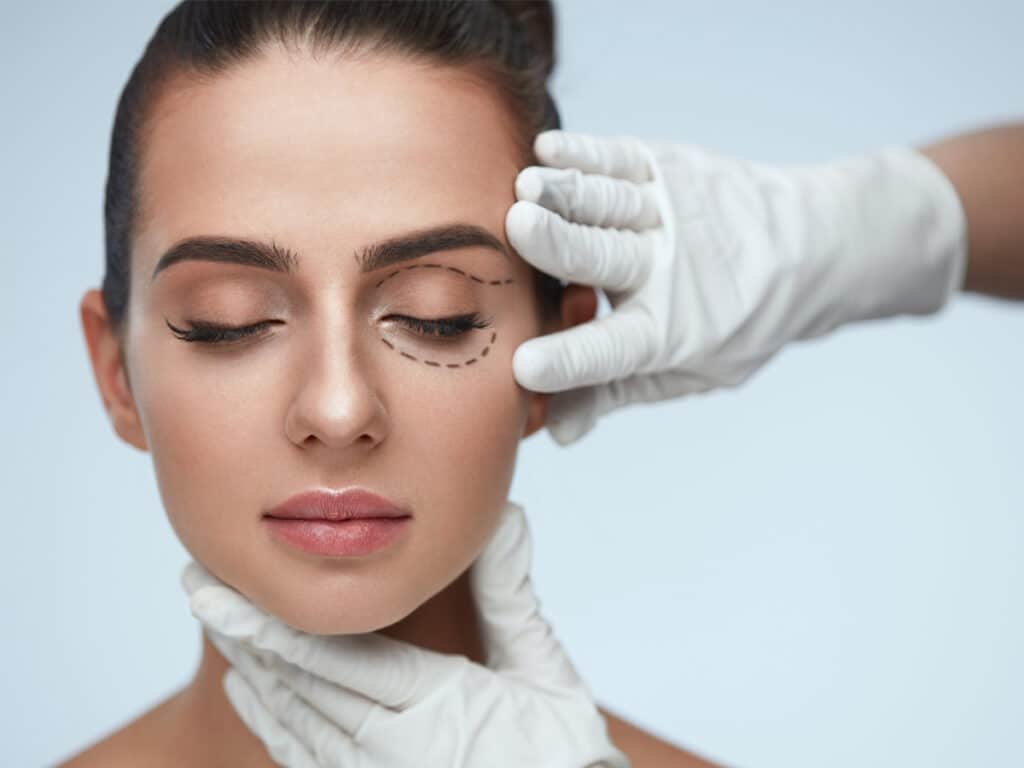Does Eyelid Surgery Leave Scars? Dr. Zamir Paez Explains

Eyelid surgery can refresh your look, help with vision issues, and reduce signs of aging. Many people consider eyelid surgery Colombia because of both expertise and value. If you are thinking “does eyelid surgery leave scars,” you are not alone. Most patients ask whether eyelid surgery scars are obvious, how visible they will be, and how Dr. Zamir Paez uses his eyelid surgery expertise to make scars as discreet as possible. This article will walk you through what to expect, how scars heal, what controls visibility, and how to take care so that your results look natural.
What Happens During Eyelid Surgery and Why Scars Form?
When you get eyelid surgery, also known as blepharoplasty, skin and sometimes fat or muscle are removed or repositioned to improve appearance or function of the eyelids. To do that an incision must be made. Every incision creates a scar. Where that incision is placed makes a big difference. For upper eyelid surgery, the cut is often made in the natural crease of the eyelid. For lower eyelids, surgeons may place it just beneath the lash line or inside the eyelid (transconjunctival approach) to reduce visible marks. Dr. Zamir Paez eyelid surgery expertise includes choosing incision locations and techniques that hide scars in natural folds so they are less noticeable.
How Visible Are Eyelid Surgery Scars Early On
Immediately after eyelid surgery, you will see eyelid surgery scars clearly. They will probably be red, swollen, possibly slightly raised. Bruising is common. During the first week or two these signs are most intense. Cold compresses, keeping your head elevated, and gentle cleaning help reduce swelling and discomfort. How visible are eyelid surgery scars during this phase depends on your skin’s sensitivity, pigment, and how well the wound is cared for. Many patients with eyelid surgery Colombia under Dr. Zamir note that though early scars look obvious, they begin to soften and fade in color as healing progresses.
The Healing Timeline: When Scars Fade?
Over the next few months eyelid surgery scars begin to improve. According to expert sources, typical timelines look like this:
- Weeks 1 to 2, you will have swelling, redness, possibly slightly raised lines
- Weeks 2 to 6, the redness fades, scars flatten, swelling reduces significantly
- Months 3 to 6, scars become lighter, thinner, less noticeable
- Between 6 and 12 months, scars continue to mature, often becoming faint lines that blend into the eyelid crease.
If you are looking at eyelid surgery scars and feeling discouraged early on, remember that true healing takes time. With proper care and by choosing a skilled surgeon, scars often become nearly invisible to casual observers.
Does Eyelid Surgery Leave Scars That Others Will Notice?
Immediately after eyelid surgery, you will see eyelid surgery scars clearly. They will probably be red, swollen, possibly slightly raised. Bruising is common. During the first week or two these signs are most intense. Cold compresses, keeping your head elevated, and gentle cleaning help reduce swelling and discomfort. How visible are eyelid surgery scars during this phase depends on your skin’s sensitivity, pigment, and how well the wound is cared for. Many patients with eyelid surgery Colombia under Dr. Zamir note that though early scars look obvious, they begin to soften and fade in color as healing progresses.
The Healing Timeline: When Scars Fade?
Over the next few months eyelid surgery scars begin to improve. According to expert sources, typical timelines look like this:
- Weeks 1 to 2, you will have swelling, redness, possibly slightly raised lines
- Weeks 2 to 6, the redness fades, scars flatten, swelling reduces significantly
- Months 3 to 6, scars become lighter, thinner, less noticeable
- Between 6 and 12 months, scars continue to mature, often becoming faint lines that blend into the eyelid crease.
If you are looking at eyelid surgery scars and feeling discouraged early on, remember that true healing takes time. With proper care and by choosing a skilled surgeon, scars often become nearly invisible to casual observers.
Does Eyelid Surgery Leave Scars That Others Will Notice?
Once healing has progressed, most people find that scars are very subtle. Upper lid scars placed in the crease are hard to see when eyes are open. Lower lid scars under the lash line or inside the lid are even more discreet. Even when others notice them especially in strong light or when eyes are closed, scars often look like fine thin lines. Dr. Zamir aims to place the incision in such a way that eyelid surgery scars are hidden in natural eyelid anatomy. Many patients say they no longer worry about scars after 3 to 6 months because the results look natural and the marks are almost unnoticeable.
Factors That Affect Scar Visibility
Several things make a difference in how visible scars become:
- Your skin type: people with very fair or thin skin may see scars more clearly early on. Those with more pigment may see discoloration or darker scars if sun exposure is not well controlled.
- Age: younger skin may heal faster, but older skin may have slower healing and less elasticity.
- Surgical technique: less tension on the incision, fine sutures, good alignment of skin edges reduce visible scarring. Dr. Zamir emphasizes incision in natural folds, careful suturing, minimal trauma to tissue.
- Aftercare: cleaning the wound well, keeping it moist, avoiding rubbing or stretching, applying recommended ointments, protecting from sun, avoiding harsh makeup or irritating agents.
Sun exposure: ultraviolet rays can cause scars to darken or stay red longer. Using sunglasses and sunscreen once allowed can help scars fade more uniformly.
Best Practices to Minimize Scarring
If you want eyelid surgery scars to heal with as little trace as possible do these:
- Follow all post‑operative instructions closely—cleaning, any ointments, avoid rubbing or pulling skin.
- Keep the head elevated for the first few nights, use cold compresses to reduce swelling.
- Limit sun exposure, especially early on. Use broad spectrum sunscreen or protective sunglasses.
- Use silicone gel sheets or scar creams when your doctor allows. Gentle massage after incision has healed may help.
- Avoid strenuous activity, avoid sleeping with pressure on the eyelids, avoid heavy makeup until incisions are fully healed.
Long‑Term Results: How Scars Mature?
Most people will find that eyelid surgery scars continue to change over a year. What begins as a red or slightly raised line gradually flattens, lightens, and fades so that by 6 to 12 months scars are minimally visible. In many cases they are visible only when someone knows where to look. Lower eyelid surgery scars that use internal or lash‑line incisions may even appear almost invisible after full healing. Patients report satisfaction increases over time as swelling settles, tissues soften, and pigment evens out.
Choosing Dr. Zamir Paez for Eyelid Surgery Expertise
Choosing a surgeon who knows eyelid anatomy well, uses incisions in natural folds, and is careful in suturing and wound closure matters a lot. Eyelid Surgery Colombia under Dr. Zamir is often selected by international patients not only for quality of results but because of his proven ability to produce subtle scars. Dr. Zamir is considered among the Best blepharoplasty surgeon in Colombia. He places incisions strategically along creases, uses techniques to minimize tension, and provides detailed aftercare guidance. When choosing where to have eyelid surgery, evaluating surgeon’s experience, hospital facility, and their scar outcomes are key steps.
Dr. Zamir Paez is a Colombian plastic surgeon specializing in eyelid surgery and facial aesthetic procedures. His practice is known for combining surgical precision with artistry and patient‑focused care. Many patients travel to Colombia seeking eyelid surgery Colombia due to his reputation, affordable yet high quality care, expertise in minimizing eyelid surgery scars, and excellent follow‑up care. Dr. Zamir Paez supports patients throughout healing, advising how to reduce visibility, protect scars, and achieve a natural, balanced outcome.
FAQs
Generally, no. Surgeons strategically place incisions to minimize visibility:
- Upper Eyelid Scars: These are hidden within the natural crease or fold of the upper eyelid, making them very difficult to see when the eyes are open.
- Lower Eyelid Scars: These are often placed just beneath the lower lash line, where the natural shadows and the eyelashes themselves help to camouflage the incision. Sometimes, a transconjunctival approach (incision inside the lower eyelid) is used, which leaves no external scar at all.
No, not completely, but they typically become extremely subtle and difficult to notice.
- Scars are permanent, but they undergo a process called maturation, where they usually lighten (fade from red/pink to skin tone) and flatten (become less raised).
- For most patients, the final appearance of the scar is a thin, pale line that often blends seamlessly with the surrounding skin texture.
Healing is a process, and there are different stages:
- Initial Visible Changes: Much of the visible swelling, bruising, and noticeable scar redness/thickness usually subsides within 3 to 6 months.
Full Scar Maturation: The scar continues to soften, flatten, and lighten for a much longer period. Complete scar maturation can take up to 12 months or even longer. The final, settled appearance of the scar isn’t truly evident until this point.
Yes, several factors can contribute to scars being more noticeable or taking longer to fade:
- Skin Tone: Individuals with darker skin tones (Fitzpatrick types IV, V, VI) have a higher risk of developing hypertrophic scars (raised, red scars) or keloids (scars that grow beyond the original wound boundary), as well as post-inflammatory hyperpigmentation (darkening of the scar area).
- Wound Tension: If the sutures or surrounding skin are under excessive tension, the scar may widen or become thicker.
- Sun Exposure: Unprotected exposure to UV radiation can cause the healing scar tissue to become darker (hyperpigmented) and more noticeable. Strict sun protection is crucial during the first year.
- Neglected Wound Care: Failing to follow your surgeon’s specific post-operative care instructions regarding cleaning, use of prescribed ointments, or avoiding irritation can negatively impact the final scar quality.
- Individual Healing: Some people are simply genetically predisposed to forming more prominent scars than others.




